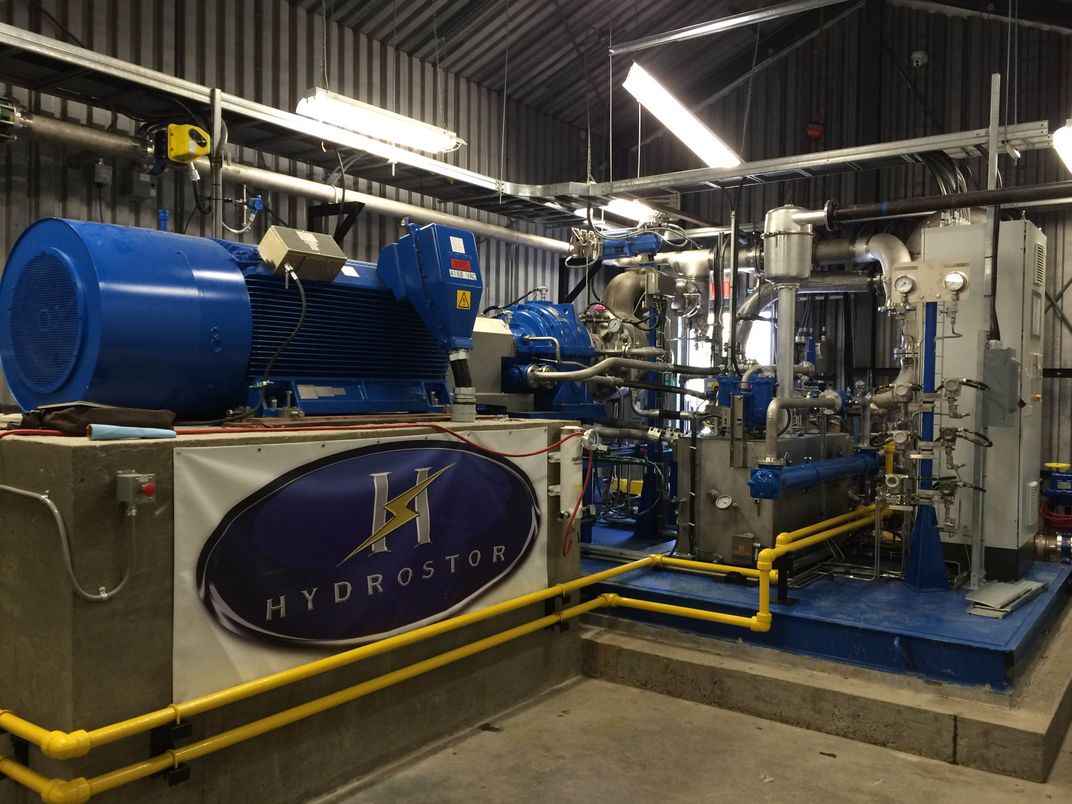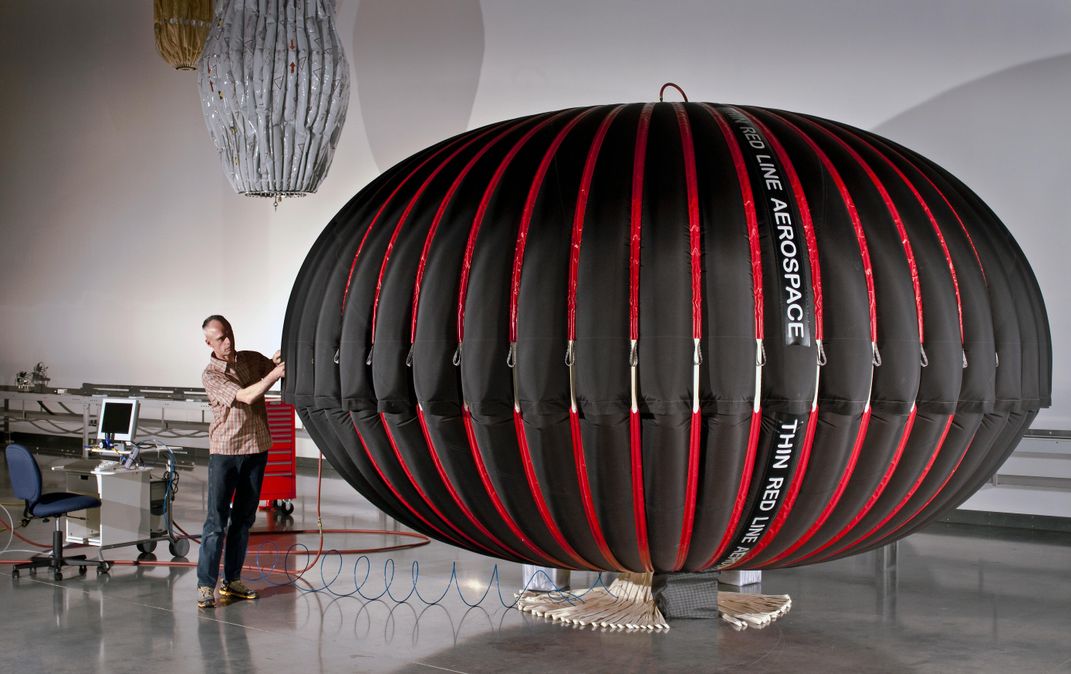Could Renewable Energy Be Stored in Balloons in the Ocean?
Underwater compressed air energy storage is promising, but the fate of this tech remains unknown
Just short of two miles off the coast of Toronto, a series of six massive, cylindrical balloons rise from the lake floor, standing almost as tall as a two-story house. Their walls contain compressed air with the potential to become electricity.
These balloons are part of an innovative, emissions-free scheme to store renewable energy from the company Hydrostor.
You see, wind energy is wonderful and solar panels are superb, and these technologies becomes more efficient every year. Yet, one of the biggest challenges for renewable energy is powering homes during off-peak times, once the winds die or after the sun sets, when communities often turn towards burning diesel.
“Storage really is the key piece to allow our electrical grid to go renewable,” says CEO of Hydrostor Curtis VanWalleghem.
Hydrostor is one of several companies and research groups who are investigating Underwater Compressed Air Energy Storage (UW-CAES), which could be a low-cost and environmentally-friendly answer to this problem.
In Hydrostor's system, excess energy from solar or wind charges an air compressor. The compressed air is cooled before it shoots down a tube and out to the massive balloons. Just like blowing up a balloon on land, the air fills up the balloons in the ocean, but because of the many feet of water pushing down, the air inside compresses. The deeper the balloons, the more air they can hold. To release the energy, operators can open an onshore valve and the overlying water forces the air out, which spins a turbine to generate power.
“Ultimately we are a very cool underwater air battery,” Cameron Lewis, founder and president of Hydrostor, says in a video released about the project.

CAES isn’t exactly new. The technology has been around since the late 19th century, though it wasn’t until the late 1970s that the first energy storage plant opened in Bremen, Germany, with compressed air underground locked in old salt caverns. Since then, there have been several CAES projects around the world, but the problem always comes down to where you put the air, says VanWalleghem. Steel tanks are extremely expensive and the current low-cost alternatives—underground caverns—are never where you need them, he says. Hydrostor's underwater balloons could at least make the energy storage method possible in communities near the ocean or deep lakes.
Sitting under roughly 180 feet of water, Hydrostor’s six test balloons measure 29.5 feet tall and 16.4 feet wide. They are made of a urethane-coated nylon, which is the same material used to haul shipwrecks from lake and sea floors—a fabric that can withstand a good deal of force from air deep underwater.
Hydrostor isn’t the only company investigating UW-CAES. Thin Red Line Aerospace independently developed a similar system, and in 2011 and 2012, they deployed several “Energy Bags” off the coast of Scotland's Orkney islands for three months. This initial pilot test gave encouraging results, which they published in a study in collaboration with a team from the University of Nottingham.
“The challenge is a step to grid scale,” says Thin Red Line's founder and president Max de Jong. Or rather, figuring out how to store enough air to produce a significant amount of energy.
Hydrostor's balloons hold a fairly small amount of energy. The company will not disclose the system’s total capacity, but the generators are capped at roughly one megawatt. Even though Hydrostor plans to scale up the system, they need quite a few more balloons to feasibly charge a community.
To give a little perspective, the London Array, an offshore, 175-turbine wind farm, produces around 4.2 percent of Greater London’s electrical power, according to de Jong. To churn out enough power to compensate for a single day lull in output, you would need around 27,500 of the smaller balloons used for Thin Red Line Aerospace's initial tests of the system, he explains. This equates to just over 7,700 of Hydrostor's bags.
“Can you imagine the plumbing, the piping … and then the environmental impact?” de Jong marvels. “That’s insanity.”
According to VanWalleghem, the parts for Hydrostor’s UW-CAES are all standard pieces carried by industrial suppliers, including General Electric. "There’s no technology or science behind us building bigger systems,” he says. “It’s just us buying a bigger motor or compressor.”
De Jong, however, argues that building larger underwater systems isn't that simple. “We know that the gas turbines are available. We know that the piping is available," he says. "The unknown part is the undersea containment and how deep you [have to] dump it to get any meaningful energy storage.”

To maximize the amount of energy an underwater system can store and pump into the grid, engineers will have to see just how big they can make the balloons and undersea ballasts, as well as how deep they can install them.
“There’s no reason why it shouldn’t work, but there are lots of reasons why it wouldn’t be economical,” says Imre Gyuk, energy storage program manager at the U.S. Department of Energy. “The question of efficiency is always there.”
As the water depth increases, there is that much more water pushing down on the balloons, allowing that much more compression of air.
"You need something immensely strong. It's almost unfathomable how strong that thing has to be," says de Jong. Based on the material used for space habitats, Thin Red Line developed and patented a "scalable inflatable fabric architecture" that can feasibly hold a whopping 211,888 cubic feet of compressed air underwater—almost 60 times more than the roughly 3,700 cubic feet in each of Hydrostor's balloons.
The other part to this solution of efficiency is going deeper, explains de Jong. His company has been investigating the idea of pairing UW-CAES with floating windmills out in the deep ocean. This solution holds the one-two punch of both massive storage potential from the great water depths and the benefits of wind turbines being out of the path of many seabirds and the sight line of people onshore. The deep storage also keeps the balloons far away from sensitive near shore environments.
There is still much testing to be done for large-scale UW-CAES to become a reality. For one, environmental impacts are still largely unknown. "Noise could be a huge thing," says Eric Schultz, a marine biologist at the University of Connecticut. "Imagine you’re forcing a bunch of gas through what I’d imagine is a fairly narrow pipe." The hiss of massive volumes of air streaming through the pipes, particularly the higher frequencies, could disrupt the behavior of ocean-dwellers. Yet the actual impact of these balloons on fish populations has not yet been verified.
VanWalleghem argues that the underwater balloon system could actually foster the marine biota, perhaps acting like an artificial reef. The balloons' anchors are covered in part by stones that are sizes and types that could support local fish spawning.
That said, as with all marine vessels, curious biota could also be a problem. “There’s always the cookie cutter shark,” says Gyuk. This cat-sized shark attaches itself to surfaces, cutting out smooth oval holes.
With the new pilot program churning along, Hydrostor eagerly awaits data to help them assess the system. The company already has plans in the works to build a bigger system in Aruba. For now, these small island communities, with relatively low energy needs and deep waters nearshore, are likely the best targets for the technology.
/https://tf-cmsv2-smithsonianmag-media.s3.amazonaws.com/accounts/headshot/Wei-Haas_Maya_Headshot-v2.png)


/https://tf-cmsv2-smithsonianmag-media.s3.amazonaws.com/accounts/headshot/Wei-Haas_Maya_Headshot-v2.png)